【免费下载】剑桥少儿英语3级上教案
- 格式:pdf
- 大小:258.04 KB
- 文档页数:5
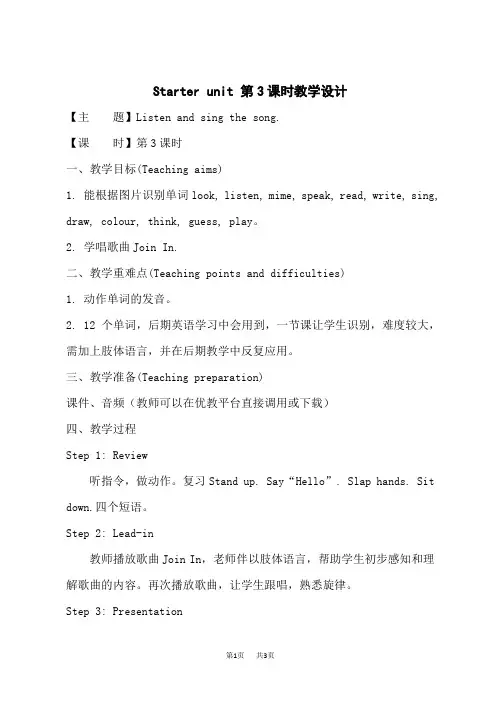
Starter unit 第3课时教学设计【主题】Listen and sing the song.【课时】第3课时一、教学目标(Teaching aims)1. 能根据图片识别单词look, listen, mime, speak, read, write, sing, draw, colour, think, guess, play。
2. 学唱歌曲Join In.二、教学重难点(Teaching points and difficulties)1. 动作单词的发音。
2. 12个单词,后期英语学习中会用到,一节课让学生识别,难度较大,需加上肢体语言,并在后期教学中反复应用。
三、教学准备(Teaching preparation)课件、音频(教师可以在优教平台直接调用或下载)四、教学过程Step 1: Review听指令,做动作。
复习Stand up. Say“Hello”. Slap hands. Sit down.四个短语。
Step 2: Lead-in教师播放歌曲Join In,老师伴以肢体语言,帮助学生初步感知和理解歌曲的内容。
再次播放歌曲,让学生跟唱,熟悉旋律。
Step 3: Presentation教师出示图片,呈现look单词。
让学生做look的动作并跟读发音。
逐一呈现listen, mime, speak, read, write, sing, draw, colour, think, guess, play,让学生感知这些单词的意思。
过程中可分小组读单词。
Step 4: Practice课堂活动:听指令,做动作。
老师说look, listen, mime, speak, read, write, sing, draw, colour, think, guess, play单词,学生做出相应的动作。
注意及时表扬,鼓励学生进行练习。
课堂游戏:金手指。
让学生打开书,老师读单词,学生快速找到单词对应的图片。
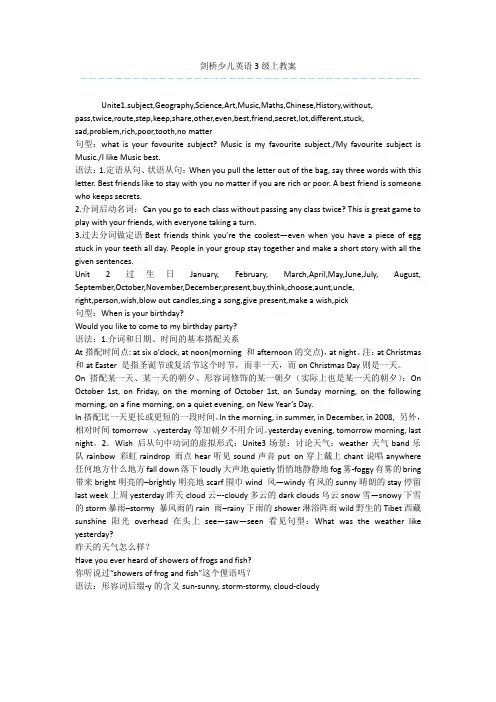
剑桥少儿英语3级上教案---------------------------------------Unite1.subject,Geography,Science,Art,Music,Maths,Chinese,History,without,pass,twice,route,step,keep,share,other,even,best,friend,secret,lot,different,stuck,sad,problem,rich,poor,tooth,no matter句型:what is your fovourite subject? Music is my favourite subject./My favourite subject is Music./I like Music best.语法:1.定语从句、状语从句:When you pull the letter out of the bag, say three words with this letter. Best friends like to stay with you no matter if you are rich or poor. A best friend is someone who keeps secrets.2.介词后动名词:Can you go to each class without passing any class twice? This is great game to play with your friends, with everyone taking a turn.3.过去分词做定语Best friends think you’re the coolest—even when you have a piece of egg stuck in your teeth all day. People in your group stay together and make a short story with all the given sentences.Unit 2 过生日January, February, March,April,May,June,July, August, September,October,November,December,present,buy,think,choose,aunt,uncle,right,person,wish,blow out candles,sing a song,give present,make a wish,pick句型:When is your birthday?Would you like to come to my birthday party?语法:1.介词和日期、时间的基本搭配关系At搭配时间点: at six o’clock, at noon(morning 和afternoon的交点),at night。
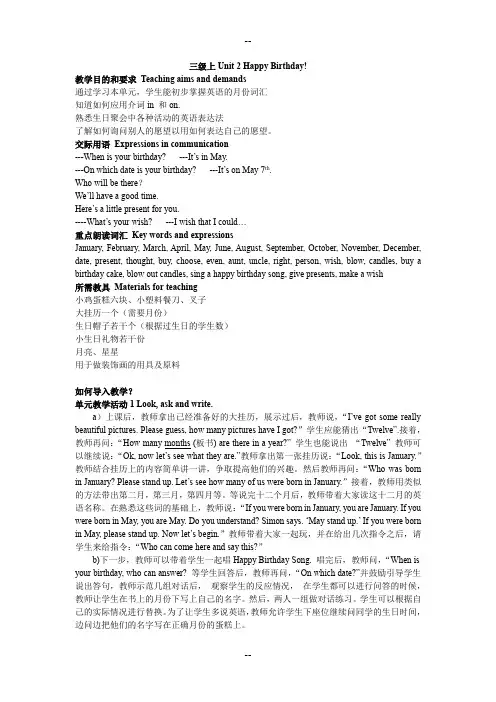
三级上Unit 2 Happy Birthday!教学目的和要求Teaching aims and demands通过学习本单元,学生能初步掌握英语的月份词汇知道如何应用介词in 和on.熟悉生日聚会中各种活动的英语表达法了解如何询问别人的愿望以用如何表达自己的愿望。
交际用语Expressions in communication---When is your birthday? ---It’s in May.---On which date is your birthday? ---It’s on May 7th.Who will be there?We’ll have a good time.Here’s a little present for you.----What’s your wish? ---I wish that I could…重点朗读词汇Key words and expressionsJanuary, February, March, April, May, June, August, September, October, November, December, date, present, thought, buy, choose, even, aunt, uncle, right, person, wish, blow, candles, buy a birthday cake, blow out candles, sing a happy birthday song, give presents, make a wish所需教具Materials for teaching小鸡蛋糕六块、小塑料餐刀、叉子大挂历一个(需要月份)生日帽子若干个(根据过生日的学生数)小生日礼物若干份月亮、星星用于做装饰画的用具及原料如何导入教学?单元教学活动1 Look, ask and write.a)上课后,教师拿出已经准备好的大挂历,展示过后,教师说,“I’ve got some really beautiful pictures. Please guess, how many pictures have I got?”学生应能猜出“Twelve”.接着,教师再问:“How many months (板书) are there in a year?” 学生也能说出“Twelve” 教师可以继续说:“Ok, now let’s see what they are.”教师拿出第一张挂历说:“Look, this is January.”教师结合挂历上的内容简单讲一讲,争取提高他们的兴趣。
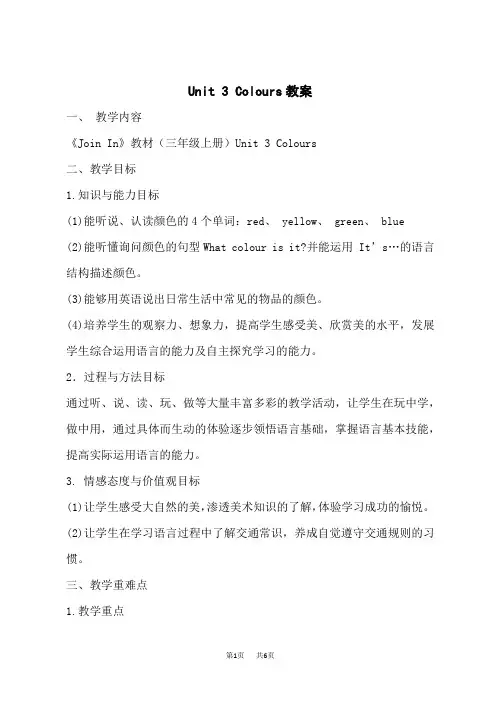
Unit 3 Colours教案一、教学内容《Join In》教材(三年级上册)Unit 3 Colours二、教学目标1.知识与能力目标(1)能听说、认读颜色的4个单词:red、 yellow、 green、 blue(2)能听懂询问颜色的句型What colour is it?并能运用It’s…的语言结构描述颜色。
(3)能够用英语说出日常生活中常见的物品的颜色。
(4)培养学生的观察力、想象力,提高学生感受美、欣赏美的水平,发展学生综合运用语言的能力及自主探究学习的能力。
2.过程与方法目标通过听、说、读、玩、做等大量丰富多彩的教学活动,让学生在玩中学,做中用,通过具体而生动的体验逐步领悟语言基础,掌握语言基本技能,提高实际运用语言的能力。
3. 情感态度与价值观目标(1)让学生感受大自然的美,渗透美术知识的了解,体验学习成功的愉悦。
(2)让学生在学习语言过程中了解交通常识,养成自觉遵守交通规则的习惯。
三、教学重难点1.教学重点(1) 认识并掌握red, yellow, green, blue四种颜色的词汇。
(2) 能听懂、会说:What colour is it? 及其答句It’s...2.教学难点(1)green中/gri:/的发音和red中/e/的发音。
(2)能活用所学的单词、句子。
四、教具准备课件,不同颜色的实物、卡片若干,画有不同女孩的图片,已剪好的不同颜色衣服卡片。
五、教学过程Ⅰ. warming up(1). GreetingsT: Hello, boys and girls.S: Hello.T: Do you like English songs?S: Yes.T: OK, l et’s begin our class with a song.(2) Sing a song: Hello. How are you?【通过师生自由对话,唱英文歌,随音乐唱唱,营造一个轻松欢快的课堂氛围,拉近师生之间的距离,让学生马上进入英语学习的状态】Ⅱ. Presentation(1)T: Are you happy?S: Yes.T: I’m happy because today is a sunny day.(老师出示一张彩虹图片) Look, what’s that ?S: 彩虹T: Yes. It’s a beautiful rainbow.It’s colourful, and it has 7 colours. So, today we are going to learn colours.【通过色彩鲜明的图片来吸引学生眼球,提高他们的兴趣。
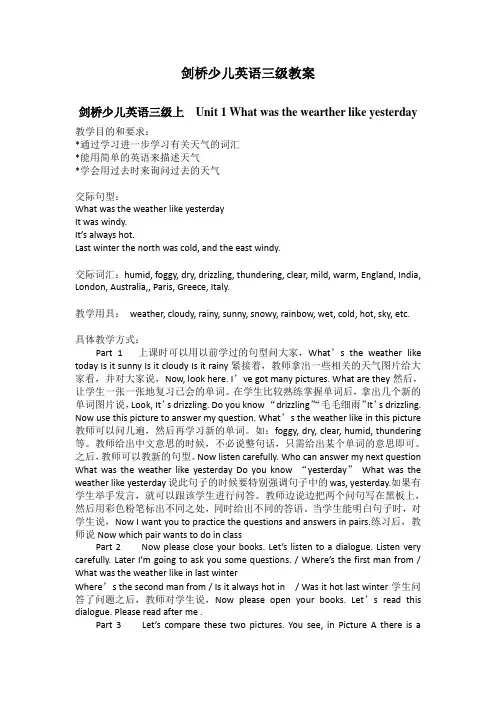
剑桥少儿英语三级教案剑桥少儿英语三级上Unit 1 What was the wearther like yesterday教学目的和要求:*通过学习进一步学习有关天气的词汇*能用简单的英语来描述天气*学会用过去时来询问过去的天气交际句型:What was the weather like yesterdayIt was windy.It’s always hot.Last winter the north was cold, and the east windy.交际词汇:humid, foggy, dry, drizzling, thundering, clear, mild, warm, England, India, London, Australia,, Paris, Greece, Italy.教学用具:weather, cloudy, rainy, sunny, snowy, rainbow, wet, cold, hot, sky, etc.具体教学方式:Part 1 上课时可以用以前学过的句型问大家,What’s the weather like today Is it sunny Is it cloudy Is it rainy紧接着,教师拿出一些相关的天气图片给大家看,并对大家说,Now, look here. I’ve got many pictures. What are they然后,让学生一张一张地复习已会的单词。
在学生比较熟练掌握单词后,拿出几个新的单词图片说,Look, It’s drizzling. Do you know “drizzling”“毛毛细雨”It’s drizzling. Now use this picture to answer my question. What’s the weather like in this picture 教师可以问几遍,然后再学习新的单词。
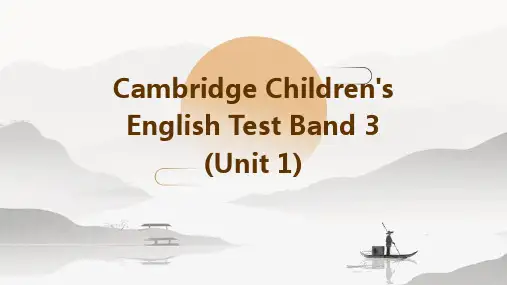
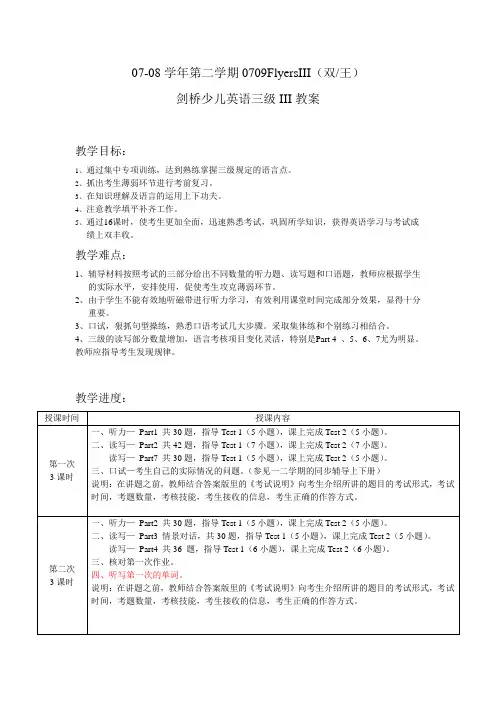
07-08学年第二学期0709FlyersIII(双/王)
剑桥少儿英语三级III教案
教学目标:
1、通过集中专项训练,达到熟练掌握三级规定的语言点。
2、抓出考生薄弱环节进行考前复习。
3、在知识理解及语言的运用上下功夫。
4、注意教学填平补齐工作。
5、通过16课时,使考生更加全面,迅速熟悉考试,巩固所学知识,获得英语学习与考试成
绩上双丰收。
教学难点:
1、辅导材料按照考试的三部分给出不同数量的听力题、读写题和口语题,教师应根据学生
的实际水平,安排使用,促使考生攻克薄弱环节。
2、由于学生不能有效地听磁带进行听力学习,有效利用课堂时间完成部分效果,显得十分
重要。
3、口试,狠抓句型操练,熟悉口语考试几大步骤。
采取集体练和个别练习相结合。
4、三级的读写部分数量增加,语言考核项目变化灵活,特别是Part 4 、
5、
6、7尤为明显。
教师应指导考生发现规律。
教学进度:。
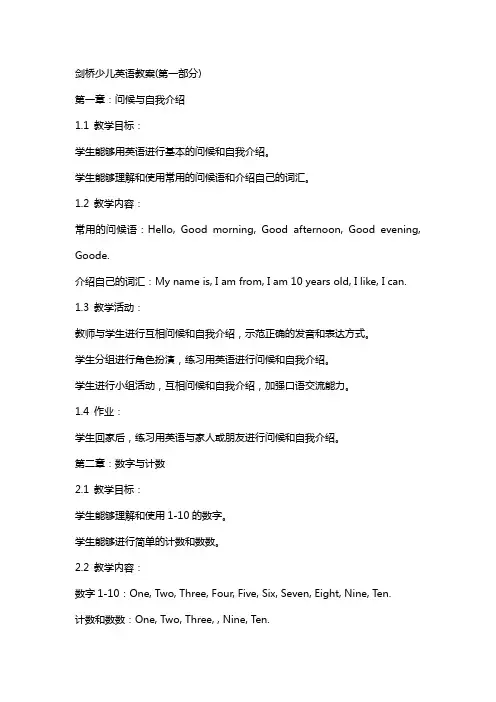
剑桥少儿英语教案(第一部分)第一章:问候与自我介绍1.1 教学目标:学生能够用英语进行基本的问候和自我介绍。
学生能够理解和使用常用的问候语和介绍自己的词汇。
1.2 教学内容:常用的问候语:Hello, Good morning, Good afternoon, Good evening, Goode.介绍自己的词汇:My name is, I am from, I am 10 years old, I like, I can. 1.3 教学活动:教师与学生进行互相问候和自我介绍,示范正确的发音和表达方式。
学生分组进行角色扮演,练习用英语进行问候和自我介绍。
学生进行小组活动,互相问候和自我介绍,加强口语交流能力。
1.4 作业:学生回家后,练习用英语与家人或朋友进行问候和自我介绍。
第二章:数字与计数2.1 教学目标:学生能够理解和使用1-10的数字。
学生能够进行简单的计数和数数。
2.2 教学内容:数字1-10:One, Two, Three, Four, Five, Six, Seven, Eight, Nine, T en.计数和数数:One, Two, Three, , Nine, Ten.2.3 教学活动:教师出示数字卡片,学生能够正确说出数字。
学生进行数数游戏,练习计数和数数。
学生分组进行数字接龙游戏,加强数字的认识和记忆。
2.4 作业:学生回家后,练习写数字1-10,并尝试进行简单的计数和数数。
第三章:颜色3.1 教学目标:学生能够理解和使用常用的颜色词汇。
学生能够描述物体的颜色。
3.2 教学内容:常用的颜色词汇:Red, Yellow, Blue, Green, White, Black, Brown, Pink, Purple, Orange.3.3 教学活动:教师出示不同颜色的物体,学生能够正确说出颜色。
学生进行颜色匹配游戏,练习识别和描述颜色。
学生分组进行颜色接力游戏,加强颜色词汇的记忆和运用。
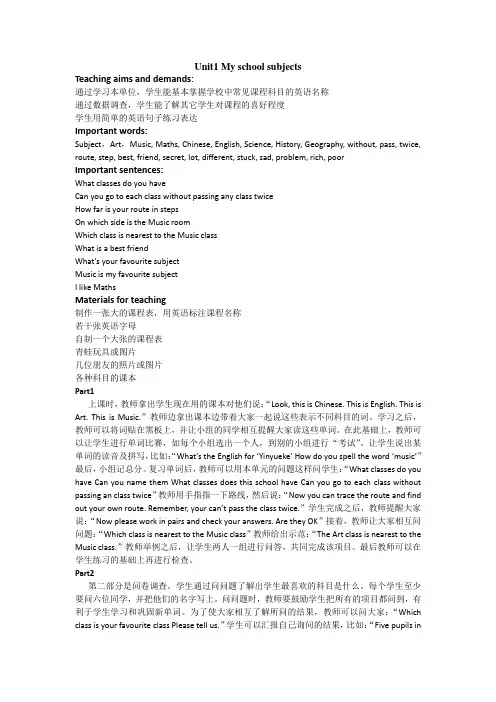
Unit1 My school subjectsTeaching aims and demands:通过学习本单位,学生能基本掌握学校中常见课程科目的英语名称通过数据调查,学生能了解其它学生对课程的喜好程度学生用简单的英语句子练习表达Important words:Subject,Art,Music, Maths, Chinese, English, Science, History, Geography, without, pass, twice, route, step, best, friend, secret, lot, different, stuck, sad, problem, rich, poorImportant sentences:What classes do you haveCan you go to each class without passing any class twiceHow far is your route in stepsOn which side is the Music roomWhich class is nearest to the Music classWhat is a best friendWhat’s your favourite subjectMusic is my favourite subjectI like MathsMaterials for teaching制作一张大的课程表,用英语标注课程名称若干张英语字母自制一个大张的课程表青蛙玩具或图片几位朋友的照片或图片各种科目的课本Part1上课时,教师拿出学生现在用的课本对他们说:“Look, this is Chinese. This is English. This is Art. This is Music.”教师边拿出课本边带着大家一起说这些表示不同科目的词。
学习之后,教师可以将词贴在黑板上,并让小组的同学相互提醒大家读这些单词。
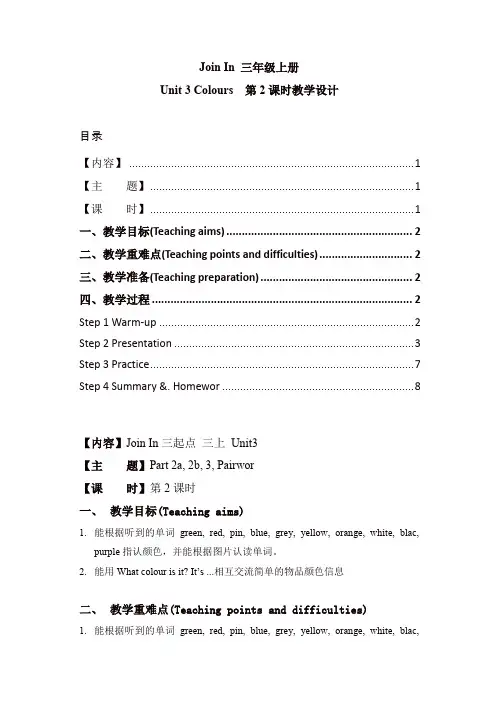
Join In 三年级上册Unit 3 Colours 第2课时教学设计目录【内容】 (1)【主题】 (1)【课时】 (1)一、教学目标(Teaching aims) (2)二、教学重难点(Teaching points and difficulties) (2)三、教学准备(Teaching preparation) (2)四、教学过程 (2)Step 1 Warm-up (2)Step 2 Presentation (3)Step 3 Practice (7)Step 4 Summary &. Homewor (8)【内容】Join In三起点三上Unit3【主题】Part 2a, 2b, 3, Pairwor【课时】第2课时一、教学目标(Teaching aims)1.能根据听到的单词green, red, pin, blue, grey, yellow, orange, white, blac,purple指认颜色,并能根据图片认读单词。
2.能用What colour is it? It’s ...相互交流简单的物品颜色信息二、教学重难点(Teaching points and difficulties)1.能根据听到的单词green, red, pin, blue, grey, yellow, orange, white, blac,purple指认颜色,并能根据图片认读单词。
2.能用What colour is it? It’s ...相互交流简单的物品颜色信息三、教学准备(Teaching preparation)慧话宝课件四、教学过程Step 1 Warm-up1.老师点开慧话宝课件,播放电影动画,让学生在日常熟悉的水果中发现颜色,并感知相应颜色的发音。
然后老师说Apple is …Red…, 引导学生跟着说Lemon is …Yellow…., 向这样把学生的注意力引导到颜色上,由此开始今天的课。
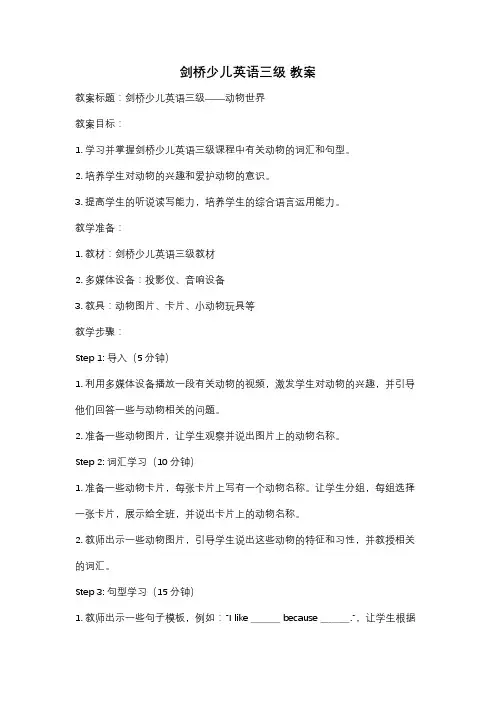
剑桥少儿英语三级教案教案标题:剑桥少儿英语三级——动物世界教案目标:1. 学习并掌握剑桥少儿英语三级课程中有关动物的词汇和句型。
2. 培养学生对动物的兴趣和爱护动物的意识。
3. 提高学生的听说读写能力,培养学生的综合语言运用能力。
教学准备:1. 教材:剑桥少儿英语三级教材2. 多媒体设备:投影仪、音响设备3. 教具:动物图片、卡片、小动物玩具等教学步骤:Step 1: 导入(5分钟)1. 利用多媒体设备播放一段有关动物的视频,激发学生对动物的兴趣,并引导他们回答一些与动物相关的问题。
2. 准备一些动物图片,让学生观察并说出图片上的动物名称。
Step 2: 词汇学习(10分钟)1. 准备一些动物卡片,每张卡片上写有一个动物名称。
让学生分组,每组选择一张卡片,展示给全班,并说出卡片上的动物名称。
2. 教师出示一些动物图片,引导学生说出这些动物的特征和习性,并教授相关的词汇。
Step 3: 句型学习(15分钟)1. 教师出示一些句子模板,例如:“I like _______ because _______.”,让学生根据自己喜欢的动物填写句子,并与同伴分享。
2. 引导学生用所学词汇和句型描述一些动物的外貌、习性等。
Step 4: 听力训练(15分钟)1. 播放教材中与动物有关的听力材料,让学生听并回答问题。
2. 制作一些与动物有关的听力练习题,例如听音选图、听音排序等,让学生进行听力训练。
Step 5: 读写训练(15分钟)1. 学生阅读教材中与动物有关的文章,并回答相关问题。
2. 让学生根据所学词汇和句型,写一篇关于自己喜欢的动物的短文。
Step 6: 温故知新(5分钟)1. 教师与学生一起回顾本节课所学的动物词汇和句型。
2. 学生分组进行问答游戏,巩固所学内容。
Step 7: 作业布置(5分钟)1. 布置课后作业:要求学生找一张自己喜欢的动物图片,并写一段关于这个动物的描述。
2. 鼓励学生多观察自然环境中的动物,积极与动物互动。
《剑桥国际少儿英语》第三册教案Unit 1 Family Matters单元目标语言:语词:aunt, uncle, daughter, son, granddaughter, grandson, grandparent, parent, children, grandparents, grandchildren, good at, science, doctor, naughty, quiet, towel, clever, at the shops, read about, catch, beard, curly, fair, moustache, straight, hair, farmer, people,pet thief, dirty, jacket, private detectives结构:所有格’s,现在进行时表示现在正在进行得动作,一般现在时,like, love, enjoy + -ing/名词, want + 不定式,简短回答Yes, I do / No, I don’t单元技能目标:听:能够听懂家庭人物的简介和描述;说:能够对家庭成员进行人物关系介绍、描述外貌以及他们现在正在进行的活动;读:能够阅读30-40个词关于人物喜好以及情景描述的小短文写:能够拼写家庭成员词汇,能够根据课文内容或个人情况进行填空、完成短文。
第一课时Lesson 1课型词汇句型目标语言重点语言家庭:aunt, uncle, daughter, son, granddaughter, grandson, grandparent, parent, 所有格’s补充语言Star一家人,then复习家庭,玩具,交通工具,I’m / She’s / He’s …, my, your, their, That’s right, Let’s …, go, play garden, Well done教学目标语言知识学生能够认读本课重点词汇;教学对象: 小学3-4年级教学时间:40 分钟/课时语言技能学生能够听懂和读懂关于家庭成员的介绍;语言运用学生能够运用本课重点语言谈论家庭成员之间的关系。
Unit3 Colours一、教学目标:1. 能正确认读规范书写字母Ll, Mm, Nn, Oo, Pp并能感知字母在单词中的发音。
2. 能根据听到的单词green, red, pink, blue, grey, yellow, orange, white, black, purple指认颜色,并能根据图片认读单词。
3. 能根据听到的单词light, milk, nose, orange, plane指认图片或实物,并能根据图片认读单词。
5. 能根据听到的句子What’s this? It’s a ... What colour is it? It’s ...给图片涂色6. 能用What colour is it? It’s ...相互交流简单的物品颜色信息,并用I like (pink) and (yellow).表达自己喜欢的颜色。
能用Good morning. Good night. 相互致以简单的问候。
7. 能学唱英语歌曲The butterfly和The rainbow。
8. 能在图片的提示下听懂、读懂小故事The wizards,并能进行简单的角色表演。
二、教学建议1a. Listen and point.听一听,指一指。
1b. Listen,point and sing.听一听,指一指,唱一唱。
Step 1 学生听歌曲,让学生在旋律优美、节奏鲜明的歌曲景下,借助图片初步感知歌曲内容。
Step 2 学生再次听歌曲,指认图片并模仿、跟唱,进一步理解表达颜色的单词。
Step 3 老师利用彩色粉笔在黑板上画一只蝴蝶,说:This is my butterfly. 再将蝴蝶的一部分涂成绿色,说:Look it’s green .让学生重复这一句话。
在蝴蝶上涂上红色圆点,指着这两种颜色说:It’s green and red.学生说的时候老师应该指着相应颜色,继续练习指导所有的颜色组合。
Step 4 让学生听表达颜色的单词并指出相应的颜色。
Unite1.subject,Geography,Science,Art,Music,Maths,Chinese,History,without, pass,twice,route,step,keep,share,other,even,best,friend,secret,lot,different,stuck, sad,problem,rich,poor,tooth,no matter句型:what is your fovourite subject? Music is my favourite subject./My favourite subject is Music./I like Music best.语法:1.定语从句、状语从句:When you pull the letter out of the bag, say three words with this letter. Best friends like to stay with you no matter if you are rich or poor. A best friend is someone who keeps secrets.2.介词后动名词:Can you go to each class without passing any class twice? This is great game to play with your friends, with everyone taking a turn.3.过去分词做定语Best friends think you’re the coolest—even when you havea piece of egg stuck in your teeth all day. People in your group stay together and make a short story with all the given sentences.Unit 2 过生日January, February, March,April,May,June,July, August, September,October,November,December,present,buy,think,choose,aunt,uncle, right,person,wish,blow out candles,sing a song,give present,make a wish,pick句型:When is your birthday?Would you like to come to my birthday party?语法:1.介词和日期、时间的基本搭配关系At搭配时间点: at six o’clock, at noon(morning 和afternoon的交点),at night。
注:at Christmas 和at Easter 是指圣诞节或复活节这个时节,而非一天,而on Christmas Day则是一天。
On搭配某一天、某一天的朝夕、形容词修饰的某一朝夕(实际上也是某一天的朝夕):On October 1st, on Friday, on the morning of October 1st, on Sunday morning, on the following morning, on a fine morning, on a quiet evening, on New Year’s Day.In搭配比一天更长或更短的一段时间。
In the morning, in summer, in December, in 2008, 另外,相对时间tomorrow 、yesterday等加朝夕不用介词。
yesterday evening, tomorrow morning, last night。
2.Wish 后从句中动词的虚拟形式:Unite3场景:讨论天气:weather天气band乐队rainbow 彩虹raindrop 雨点hear听见sound声音put on穿上戴上chant说唱anywhere任何地方什么地方fall down落下loudly大声地quietly悄悄地静静地fog雾-foggy有雾的bring带来bright明亮的–brightly明亮地scarf围巾wind 风—windy有风的sunny晴朗的stay停留last week上周yesterday昨天cloud云---cloudy多云的dark clouds乌云snow雪—snowy下雪的storm暴雨–stormy 暴风雨的rain 雨–rainy下雨的shower淋浴阵雨wild野生的Tibet西藏sunshine 阳光overhead在头上see—saw—seen看见句型:What was the weather like yesterday?昨天的天气怎么样?Have you ever heard of showers of frogs and fish?你听说过“showers of frog and fish”这个俚语吗?语法:形容词后缀-y的含义sun-sunny, storm-stormy, cloud-cloudyUnite 4 问路、指路square广场正方形lake湖泊street街道palace宫殿university大学turn right / left 向右/左转minute 分钟foreign外国的easy容易的—easily容易地city城市other其他的ticket票subway地铁world世界get round逛游览show 出示展示driver司机language语言biking骑自行车along 沿着way 道路方法pay for支付be able to能够traffic lights红绿灯knee膝盖winner获胜者happen发生far-further –furthest远(最高级)block积木smooth 光滑的rough 粗糙的top顶部push推句型:How far is it from Xidan to Wangfujing Street? 从西单到王府井有多远?You should turn left. 你应当向左拐。
You should go straight on. 你应当一直走。
How long does it take by taxi? 坐出租车要多长时间?It takes about 12 minutes. 大约12分钟。
You’re welcome. 不客气。
语法:it的用法小结:表示时间、距离、天气等。
Unite 5 询问事物的称呼、询问对方完成动作情况:robot机器人helper帮手助手finish完成结束already已经golf高尔夫drum 鼓rucksack帆布背包旅行包sledge雪橇suitcase行李箱torch手电tent 帐篷pyramid金字塔diary日记finger手指tadpole蝌蚪camp野营营地life生活生命own 自己的hind 后面的dangerous危险的king国王的queen女王water lily荷花pond 池塘hurt伤害受伤learn a lesson得到教训句型:Have you finished your homework? 你完成作业了吗?No, I haven’t.没有。
Don’t worry! I’ve got a helper. 别担心!我有一个助手。
What’s he called? 他叫什么?Is he helping you do homework? 他正帮你写作业吗?Have you got a robot to help you? 你有机器人帮你吗?There’s too much. 太多了。
语法:被动句基本情况,现在完成时小结Unite 6 讨论事物的外部特征lizard蜥蜴octopus章鱼zebra斑马silver银子银candle蜡烛metal金属ring环状物耳环striped条纹的dinosaur恐龙wool羊毛sandwich三明治feel感觉sound听起来smell闻起来taste尝起来chocolate巧克力heatproof 抗热的bowl碗saucepan深平底锅chopstick筷子knife刀member成员roast 烘烤rubber橡胶My goodness! 我的天呀meat肉careful 小心的stomach胃toilet=washroom 洗手间heat加热melt溶化stick棍foil 衬布terrible可怕的cover遮盖覆盖themselves他们自己.句型:what’s it like? What does it sound like? It sounds like a dog. 语法:感觉动词的系动词用法:feel, sound, look, smell, taste, etc.比较:感觉动词的及物动词用法Unite 7 讨论住房house 房子tent帐篷town house城市中的住宅floating house 漂浮的房子apartment=flat公寓楼房cave 窑洞洞hut茅屋棚屋castle城堡bedroom卧室bathroom 卫生间dining room 餐厅kitchen厨房downstairs在楼下upstairs在楼上living room 客厅balcony 阳台mobile house汽车房子all over the world 偏激全世界thousands of 成千上万grow种植生长even 甚至偶数digit数字field田地wheat小麦until直到clear清理干净的 a few几个homeless无家可归的teapot茶壶magazine 杂志sweet甜蜜的warm 温暖的句型:I can’t remember where I put my envelopes? William is going on holiday.语法:1.where 引导的宾语从句比较:where 引导的定语从句:They had found a place where they could live.2. 过去完成时基本概念Unite 8 时间话题use运用使用London Bridge伦敦桥Great Wall of China中国长城pyramid 金字塔dinosaur恐龙fire火World Wide Web全球信息网global village地球村space walk太空行走future未来将来quarter十五分钟一刻钟exist存在Manchester 曼彻斯特university 大学since自从build-built 建造建立fly-flew-flown飞restore重建around 大约programme 节目程序USSR 苏联complete 完成ago以前half 一半asleep睡着的remember记得measure测量century世纪church教堂Milan 米兰second秒第二minute分钟mean意思是表示believe相信lower低下tape磁带calendar日历sandglass沙漏candle clock蜡烛表weight-driven clock 重量表spring-driven clock 弹簧表pendulum clock摆钟句型:Tom Kilburn wrote the world’s first computer programme in 1948 at Manchester University. It’s a quarter to(past) eight. 语法:钟点表示法总结Unite 9 场景:集体活动单词:Australia澳大利亚countryside乡村waterfall瀑布camp野营enjoy喜欢hope希望different不同的museum博物馆playground操场bookshop书店swan天鹅idea主意pyramids金字塔camel骆驼science科学mean意指句型:Shall we go camping next summer together? What shall we do this Sunday?Which summer camp would you like to go to? What do camels eat? How does a computer work? What does “science”mean? Where are the pyramids? Why am I short? What would you like to know?语法:情态动词shall 表示建议的用法Unite 10 谈论去过的地方airport机场restaurant餐馆circus马戏团science科学museum博物馆bank银行chemist’s药店golf club高尔夫俱乐部fire station消防站London伦敦police station警察局tape recorder录音机businessman商人college大学sandwich三明治fridge冰箱crowded拥挤的wish愿望句型:Have you ever been to science museum? Yes, I have. No, I haven’t. Where have you been? I haven’t seen you for ages. Which exhibit do you like best? What are the children doing? Did you have a good time there? Where does the light come from?语法:Have been 和have gone 表示去某地时的意义对比Unite 11 物体的材质material材料chopsticks筷子recycle再利用carefully仔细地special特殊的plastic塑料bookcase书柜wood木头paper纸metal金属glass玻璃wool羊毛silver银plate盘子cupboard橱柜shelf架子fork叉子fridge冰箱cooker厨具scissors剪刀spoon勺子watch手表gloves手套shell贝壳empty空的useless无用的happen发生china瓷器light轻的weak脆弱的expensive贵的noisy吵的hard硬的heavy重的ugly丑的cheap便宜的句型:What’s it made of? It is made of plastic. What’s special about it? What do you think of the following things? How about that one It’s too light.语法:1.made of 和made from区别; 2. 成对物体数量表示法Unite 12 场景:体育比赛单词:basketball篮球wrestling摔跤baseball棒球athlete运动员Olympic Games奥运会gold medal金牌high jump跳高long jump跳远diving跳水water polo水球badminton羽毛球boxing拳击baseball棒球rowing划船volleyball排球handball手球cycling自行车shooting射击protect保护environment环境volunteer志愿者historical interests名胜古迹句型:Help foreign friends find the way. Carry our “Five-star” red flag while watching the games. Who is the best player? Where was he born?语法:1.across 表示位置的用法:Sarah’s brother is directly across the net from her daughter. 对比:He walked across the street. 2. whoever, wherever等的意义和基本用法 3. make 后复合宾语中不定式省略to;对比:被动语态时的情况。